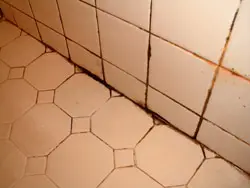Mold
! ! IMPORTANT - Read Author's Notes Below ! !
DEAR TIM: We recently purchased a seven year old home that has a full unfinished basement. The walls have studs, insulation and a vapor barrier but no drywall yet. We are thinking of installing drywall but the rear wall has lots of mold growing on the insulation and vapor barrier. What is causing this to happen? How can we stop the growth? How can the mold be removed? Tim and Peggy W., Eagan, MN
DEAR TIM and PEGGY: You are lucky you discovered this mold before you installed the drywall. Anytime you see mold growing on a surface inside your home consider it to be a brilliant red flashing light signaling that you could have a serious problem or might have one in your immediate future. A wise person takes immediate action to fix mold problems because certain molds can cause serious health problems and in rare instances death.

This is typical mold in a shower. There is no excuse for this. The homeowner simply needs to clean the shower every two weeks and keep the shower door open so the space can dry quickly.
Mold is around us 24 hours a day in the form of airborne spores and spores that have settled onto every surface inside a home. These spores are similar to plant seeds. Think of them as time bombs waiting to go off. In almost all instances they already have two of three of the necessary ingredients to grow and thrive. The temperature inside of most homes, crawlspaces and attics is almost always sufficient to support mold growth. The surfaces that the mold spores rest upon are in almost all instances a food and nutritional source. Mold will thrive on drywall paper, wood, certain paints, fabrics, dust, paper, carpet, etc. Soaps and other body care products that often create a film inside tubs and showers are a smörgåsbord for mold. Mold can easily grow inside a cold refrigerator.
The third ingredient that triggers the mold spore time bombs is water. Surfaces that become wet from plumbing leaks, roof leaks, condensation, pet urine, etc. can sprout mold growth in several days or less. If the surfaces stay wet for extended periods of time, the mold can grow at an astounding rate. Relative humidity levels of 50 percent or greater can supply enough moisture in the air that condensation can start to happen at temperatures close to the actual surface temperature of the object. Water vapor from your basement space probably turned into condensation when it came into contact with the cold insulation and vapor barrier on that rear wall.
Common molds that cause health problems in adults and children often fall into two main categories. Penicillium and Aspergillus are two common indoor molds. Cladosporium and Alternaria are common outdoor molds that get brought indoors. Innocent pieces of slightly damp firewood can contain vast amounts of mold. Once thrown onto the fire, mold spores can be pumped into the house by indoor air currents that circulate in and around the fireplace. Seemingly harmless cut and live Christmas trees can be loaded with outdoor mold spores. Damp mulch in garden beds can liberate millions of spores and these can enter open windows. Forget about stopping mold spores from getting into your home. It is virtually impossible
The key to stopping or halting mold is to cut off its supply of water. Vent dryers outdoors. Install high quality fans that remove water vapor from baths and kitchens. Cover crawlspace dirt with high performance vapor barriers. Fix plumbing and roof leaks immediately. Stop water infiltration into basements and crawl spaces by installing hidden linear French drains around your home. These simple trenches filled with perforated pipe and gravel can intercept and redirect water away from your home. Install excellent ridge and soffit ventilation systems. Seal leaks in brick homes caused by wind driven rains with high performance breathable silane and siloxane water repellents. You can stop your mold growth by lowering the relative humidity in your basement or by raising the indoor temperature.
Cleaning mold is fairly simple. A solution of 4 parts water and 1 part chlorine bleach can be used to remove mold from tile, concrete, grout and other surfaces that are not harmed by the harsh chlorine. Fabrics, carpet, painted walls, wood, clothing, etc. can be cleaned using non-toxic oxygen bleach. Oxygen bleach is a powder that is mixed with water. It is readily sold on the Internet and on cable television. Some national club membership stores carry it as well. It is best to buy it in its pure form. Many companies that sell oxygen bleach add fillers to the product. Find one that is 100 percent pure oxygen bleach.
Author's Notes - August, 2004
Today I received a very helpful email from Ms. Sue McGregor-Hunter, the Executive Director of the Peterborough Green-Up in Canada about some new information about mold clean up. Sue wrote:
"... In our research from agencies such as the EPA, we have found that bleach is no longer recommended as a cleaning agent. Yes, bleach "kills" the mold but dead mold is a toxic as live mold. The homeowner has to completely remove it, if they are to suffer no ill health effects. It is recommended that they clean with a unscented detergent (so that the scent does not mask the smell of the mold - one of the clues to the homeowner that mold is still present) and then use a HEPA vacuum to thoroughly clean. They must repeat the process until it is completely gone. Not quite as simple but more effective for health effects ...."
Sue McGregor-Hunter
Executive Director
Peterborough Green-Up
360 George Street North
Unit 42
Peterborough, Ontario
K9H 7E7
Thanks for this heads up! TC
Column 344